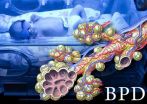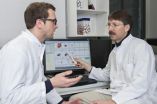(Press-News.org) Researchers at Yale School of Medicine have made major discoveries that could lead to new treatments for lung disorders in premature babies. In a mouse study, the team located key molecules that switch on stress pathways in preterm lung disorders, and also found that when parts of these pathways were blocked with a pain drug, lung damage was prevented or reversed.
The findings are published online ahead of print in the March issue of American Journal of Respiratory Cell and Molecular Biology.
Bronchopulmonary dysplasia (BPD) is the most common chronic lung disease in premature infants and does not have any specific treatment. The disorder affects about 97% of infants with birth weights below 1,250 grams, and can lead to repeated respiratory tract infections, as well as to emphysema and chronic obstructive pulmonary disease in adulthood.
A research team led by Vineet Bhandari, M.D., associate professor of pediatric neonatology and obstetrics, gynecology & reproductive sciences at Yale School of Medicine, theorized that if the molecules that cause these disorders can be blocked early on, they could essentially prevent lifelong lung problems.
Bhandari and his team studied the lung tissue of newborn mice. The team noted that when this lung tissue was exposed to hyperoxia —excess oxygen in tissues and organs that activates all components of the stress pathways in the newborn lung— there was a marked increase of cyclooxygenase 2 (Cox2) in the lung's stress pathways. This action resulted in BPD in mice. Once the team used a drug that inhibits Cox2, they were able to reverse BPD in mice.
"This is the first time hyperoxia has been comprehensively shown to be responsible for activating the stress pathway in developing lungs," said Bhandari. "Hyperoxia can induce interferon gamma and disrupt lung development, leading to BPD in mice. Once we used the Cox2 inhibitor Celecoxib, we were able to reverse the effects in the mouse BPD models. The drug, originally indicated to treat pain, protected the lungs from cell death, and was able to prevent destruction of and damage to the developing lung exposed to hyperoxia or excess interferon gamma in room air."
Bandari added that the findings suggest that Cox2 and or CHOP — a molecule important in the stress pathway — are potential new drug targets that can be inhibited to treat or prevent human BPD.
Bhandari said the next step is to conduct pre-clinical studies.
INFORMATION:
Other authors on the study include Rayman Choo-Wing; Mansoor A. Syed; Anantha Harijith, M.D.; Brianne Bowen; Gloria Pryhuber; M.D.; Cecilia Janér, M.D.; Sture Andersson, M.D.; and Robert J. Homer, M.D.
Citation: Am. J. Respir. Cell. Mol. Biol. doi:10.1165/rcmb.2012-0381OC (March 2013)
Researchers spot molecular control switch for preterm lung disorders
2013-03-20
ELSE PRESS RELEASES FROM THIS DATE:
Family dinners nourish good mental health in adolescents
2013-03-20
Regular family suppers contribute to good mental health in adolescents, according to a study co-authored by McGill professor Frank Elgar, Institute for Health and Social Policy. Family meal times are a measurable signature of social exchanges in the home that benefit adolescents' well-being – regardless of whether or not they feel they can easily talk to their parents.
"More frequent family dinners related to fewer emotional and behavioural problems, greater emotional well-being, more trusting and helpful behaviours towards others and higher life satisfaction," says Elgar, ...
FEMA's National Flood Insurance Program needs an updated approach to analyzing flood risk
2013-03-20
WASHINGTON -- In administering the National Flood Insurance Program, the Federal Emergency Management Agency (FEMA) needs a more modern approach to analyzing and managing flood risk behind levees -- one that would give public officials and individual property owners a clearer idea of the risks they face and how they should address them, says a new report from the National Research Council. Because levees can reduce but not eliminate the risk of flooding, the agency should also encourage communities behind levees to use multiple methods to reduce risk and increase awareness ...
Study suggests demographic factors can predict risk of operative births in UK women
2013-03-20
Independent maternal demographic factors such as social status, ethnicity and maternal age can predict the likelihood of operative births in the UK, according to a new study published today (20 March) in BJOG: An International Journal of Obstetrics and Gynaecology.
The study, conducted by researchers in the Department of Health Sciences at the University of York, explores which women are at an increased risk of an operative birth, including caesarean section (CS) or instrumental vaginal birth. It looks at data from the Millennium Cohort Study of babies born in the UK ...
AGU: Voyager 1 has left the solar system, sudden changes in cosmic rays indicate
2013-03-20
WASHINGTON – Thirty-five years after its launch, Voyager 1 appears to have travelled beyond the influence of the Sun and exited the heliosphere, according to a new study appearing online today.
The heliosphere is a region of space dominated by the Sun and its wind of energetic particles, and which is thought to be enclosed, bubble-like, in the surrounding interstellar medium of gas and dust that pervades the Milky Way galaxy.
On August 25, 2012, NASA's Voyager 1 spacecraft measured drastic changes in radiation levels, more than 11 billion miles from the Sun. Anomalous ...
NIST tests underscore potential hazards of green laser pointers
2013-03-20
Using a low-cost apparatus designed to quickly and accurately measure the properties of handheld laser devices, National Institute of Standards and Technology (NIST) researchers tested 122 laser pointers and found that nearly 90 percent of green pointers and about 44 percent of red pointers tested were out of compliance with federal safety regulations. The NIST test apparatus was designed so that it can be replicated easily by other institutions.
As NIST researchers reported at a conference on March 20, 2013,* both red and green laser pointers often emitted more visible ...
Clues point to cause of a rare fat-distribution disease
2013-03-20
Studying a protein that gives structure to the nucleus of cells, Johns Hopkins researchers stumbled upon mutations associated with familial partial lipodystrophy (FPLD), a rare disease that disrupts normal patterns of fat distribution throughout the body.
"Our findings open new paths for learning how and why fat cells are disproportionately affected by mutations in the protein lamin A, which is found in the nucleus of most cells of the body," says Katherine Wilson, Ph.D., professor of cell biology at the Johns Hopkins University School of Medicine.
According to the ...
A step forward in the treatment of chronic urticaria
2013-03-20
This press release is available in Spanish.
Barcelona, 20th March 2013.- An international study involving dermatologists from the Hospital del Mar and Spanish subjects has concluded that a drug normally used to treat severe bronchial asthma caused by allergies (Omalizumab) rapidly eliminates the symptoms of spontaneous chronic urticaria, a development that it is expected will significantly improve the quality of life of chronic urticaria sufferers.
Spontaneous chronic urticaria, one of the most common skin diseases, consists of an abrupt reaction that results in hives ...
Metal stents are effective treatment for blocked bile ducts
2013-03-20
NEW YORK (March 20, 2013) -- A multi-center analysis, led by Weill Cornell Medical College and published in the Journal of Clinical Gastroenterology, shows the use of temporary "fully covered self-expanding metal stents" (FCSEMS) can effectively fix a painful and potentially life-threatening benign biliary stricture -- a severely blocked or narrowed bile duct.
"Benign biliary strictures can be managed and resolved with these new fully covered metal stents with flared ends. Our study findings are similar to the recent European study results in patients overseas who received ...
Insights into the immune system, from the fates of individual T cells
2013-03-20
By charting the differing fates of individual T cells, researchers have shown that previously unpredictable aspects of the adaptive immune response can be effectively modeled. The crucial question: What determines which of the immune system's millions of cells will mobilize to fight an acute infection and which will be held back to survive long-term, forming the basis of the immunological memory? The scientists' findings, published in the journal Science, could have implications for improved immunotherapy and vaccination strategies.
The scientists found that the immediate ...
United States should execute new strategy toward Syria, Baker Institute special report says
2013-03-20
HOUSTON – (March 20, 2013) – As Syria's raging civil war approaches the two-year mark, the United States should prepare a more focused strategy that strengthens the moderate political forces in Syria and engages Syria's regional and international stakeholders, according to a new special report from Rice University's Baker Institute for Public Policy. The report also recommends that U.S. strategy should buttress Syria's neighbors, address the deepening humanitarian crisis and plans for a post-Assad Syria.
The special report, "Syria at the Crossroads: United States Policy ...


